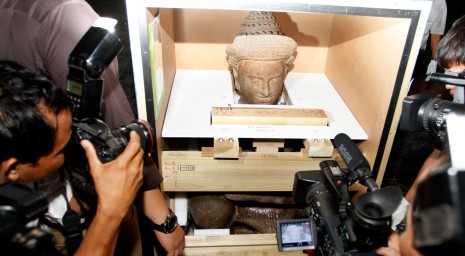Under the attentive eyes of government officials and a crush of photographers and reporters, the Metropolitan Museum of Art in New York on Tuesday evening returned two 10th-century statues, known as the “Kneeling Attendants,” to Cambodia.
The statues were stolen from the Koh Ker temple complex in Preah Vihear province in the turmoil of the 1970s and had been on display at the Met’s Southeast Asia department since the 1980s.

After the statues’ 1.2-meter tall metal containers were placed at Phnom Penh International Airport’s VIP area, cargo handlers carefully removed the screws and lifted the sidewalls, unveiling the twin sandstone statues to a welcoming party of Buddhist monks, government officials and journalists.
“This is very significant for our cultural heritage as a whole. They were lost since the 1970s,” said Chuch Phoeurn, secretary of state at the Ministry of Culture and Fine Arts.
The repatriated “Kneeling Attendants” are two of a group of five “Pandava” brother statues, which once stood at the Prasat Chen temple in Koh Ker. The three other brother Pandavas are believed to be in the hands of private collectors or museums.
Mr. Phoeurn said the Met had set a precedent in returning the statues, and had set an example that could see many other looted Khmer statues returned from museums and private collectors around the world.
“This is a very high contribution,” Mr. Phoeurn said of the Met’s decision.
Chan Tani, secretary of state at the Council of Ministers, extended his gratitude to representatives of the Met, who accompanied the statues and were present at the unveiling.
“We lost a lot during the civil war and we are now trying to rebuild [our cultural heritage]. This is part of our culture, and you can not live without culture,” Mr. Tani said.
The Met announced in May that it would return the statues, which each weigh some 90 kg, as new evidence had proved that the artifacts were looted from Prasat Chen.
According to the Met, a London-based art dealer donated the head of one “Kneeling Attendants” to the Museum in 1987. It was followed two years later by the head of the second attendant. Subsequently, the torsos were acquired, and the Met restored both figures.
Speaking at the airport, Maxwell Hearn, head of the Met’s Asian Art department, said he was honored to participate in the rightful return of the statues.
“Because of new information that the Met learned, and how the statues left Cambodia, we felt it’s important to return them,” Mr. Hearn said.
Some experts have argued that the statues should remain at the Met, where millions of people visiting New York’s foremost museum were able to see them flanking the entrance of the Southeast Asian Gallery for almost two decades.
“We have over six million visitors [each year], who will never have the chance to go to Cambodia and who could have seen the status at our museum,” Mr. Hearn added.
After a short ceremony in which monks blessed the statues, they were placed onto a white truck and transported to the National Museum, said Hab Touch, director of the Ministry of Culture’s department for cultural heritage.
“We have to check the condition together with conservationist from the Met. The [original] pedestals [from Prasat Chen] are already waiting at the museum,” he said, adding that the statues would be on display briefly before being transported to Prime Minister Hun Sen’s office, known as the Peace Palace, for the 37th Session of the World Heritage Committee, which begins Sunday.
“After, I hope they go back to the National Museum, but it depends on the government,” Mr. Touch said.
In a statement, the Council of Ministers said Tuesday that a total of nine free-standing figures depicting a battle from the Mahabharat tale were looted from Prasat Chen.
The figures were at the temple “for more than a thousand years until being brutally hacked from their pedestals in the early 1970s, when Cambodia was in a state of civil war, and illicitly taken across the border and placed on the international art market,” according to the statement.